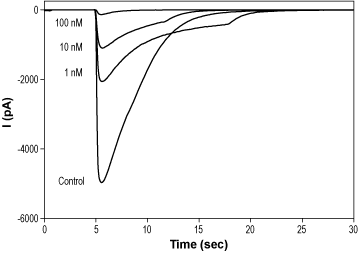Overview
Serotonin (5-hydroxytryptamine, 5-HT) is a monoamine neurotransmitter synthesized from the amino acid Tryptophan by the enzyme tryptophan-decarboxylase. The 5-HT3 channel is a ligand-gated ion channel receptor of the cys-loop channel family. It is a pentamer with five subunits surrounding a central channel1.
Tropisetron hydrochloride is a synthetic, potent and selective antagonist of 5-HT3A channel. In fluorescence polarization it was found to have an affinity 8.31 pKi (M) for 5-HT3A receptor2. Tropisetron binds to an extracellular domain of the receptor. Tropisetron was found to have an analgesic and anti-inflammatory activity via inhibition of lipopolysaccharide (LPS) stimulated tumor necrosis factor (TNF) and interleukin-1-β release from human monocytes. This inhibition is conducted by preventing the phosphorylation of the p38 mitogen activated kinase (MAPK)3. Interestingly, when combined with acetaminophen in an experimental pain inducing assay, Tropisetron blocked the analgesic effect of acetaminophen thus indicating that perhaps the analgesic action of acetaminophen is also mediated through 5-HT receptors4.
Specifications
Technical Specifications
Biological Activity
- Seynaeve, C. et al. (1991) Anticancer Drugs 2, 343.
Solubility and Storage
Applications
 Alomone Labs Tropisetron Hydrochloride blocks 5HT3A receptors expressed in HEK 293T cells.Currents were elicited by 10 µM 5-HT, delivered every 3 minutes. Tropisetron hydrochloride (#T-125) was applied 30 seconds before stimulation at 1, 10 and 100 nM, as indicated and inhibited the 5-HT induced current in a dose-dependent and reversible manner.
Alomone Labs Tropisetron Hydrochloride blocks 5HT3A receptors expressed in HEK 293T cells.Currents were elicited by 10 µM 5-HT, delivered every 3 minutes. Tropisetron hydrochloride (#T-125) was applied 30 seconds before stimulation at 1, 10 and 100 nM, as indicated and inhibited the 5-HT induced current in a dose-dependent and reversible manner.

